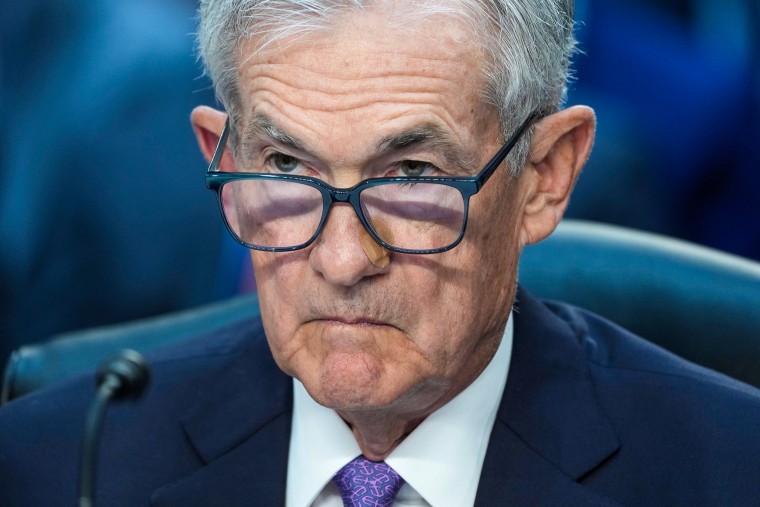
The Federal Reserve announced Thursday it was lowering its key interest rate by a quarter-point — a widely expected move that coincides with
inflation
approaching
the central bank’s 2% goal.
In their statement
, Fed officials noted that inflation remains “somewhat elevated” while unemployment has “moved up but remains low.” They did note that conditions in the labor market have “generally eased” — perhaps a nod to signs of growing softness in hiring.
Some market participants noted the officials removed key language that had indicated it was still confident it would hit the 2% inflation target.
In a note to clients, Omair Sharif, president of Inflation Insights, said that may signal a new willingness by the Fed to forgo a widely expected additional quarter-point cut next month: “If that is the case, then the Committee is likely closer to a pause.”
In other words, the central bank would keep rates elevated.
As the pain from four years of breakneck price growth linger, there are concerns that President-elect Donald Trump’s economic plan, especially his tariff proposal, could spark a new inflationary environment.
As of Wednesday, Wall Street traders were
nearly unanimous
that the Fed would cut the federal funds rate, which acts as a benchmark for other borrowing rates in the economy, by a quarter-point. The central bank is looking to dial back the restrictive lending environment it put in place to rein in the surging inflation that took hold amid the pandemic.
With that cut, the central bank’s federal funds rate falls to a 4.5%-to-4.75% range.
Heading into Tuesday’s presidential vote, the Fed would have been justified in celebrating the return of inflation
back to its 2% target
.
At the same time, unemployment remains subdued at 4.1%.
In essence, the Fed has satisfied its dual mandate of keeping inflation and unemployment low.
But the arrival at that finish line now coincides with Trump’s
promise to enact an entirely new fiscal and economic regime
. While analysts remain uncertain about how exactly that could materialize and how severe it might be, markets have already responded by selling off bonds in anticipation of a return to inflation from a combination of Trump’s pro-growth and combative trade policies.
That would cause the Federal Reserve to pause its current trajectory of steadily lowering interest rates.
And that, in turn, would run directly counter to Trump’s goal of maintaining lower interest rates as part of a policy of accelerating economic growth.
“Although Trump has shown a consistent preference for easy monetary policy, we believe that the Fed would engage in a less aggressive cutting cycle under a second Trump administration due to the inflationary nature of additional tariffs,” analysts with Nomura Holdings financial group wrote in a note to clients this fall.
Trump and the GOP have denied the tariffs would be inflationary, pointing to Trump’s success in imposing tariffs in his first term without reigniting inflation.
“In his first term, President Trump instituted tariffs against China that created jobs, spurred investment and resulted in no inflation,’’ Anna Kelly, a spokeswoman for the Republican National Committee, has said.
Yet those tariffs, at $300 billion on selected Chinese goods, were much more targeted than the $3 trillion worth of blanket tariffs Trump is now expected to propose. And the inflationary environment is different now, too: During Trump’s first term, inflation only briefly ever climbed above 2%.
David Seif, chief economist for developed markets at Nomura, said Fed Chair Jerome Powell is likely to deflect any direct questions he gets Thursday about how he perceives his role and responsibilities will change once Trump takes office.
It was Trump who appointed Powell to lead the Federal Reserve in his first term. But Trump has signaled a willingness this year to abandon the long-running principle of maintaining the Fed as an independent body.
“I think I have the right to say, I think you should go up or down a little bit,” Trump said in a Bloomberg News interview at the Chicago Economic Club last month, according to Reuters. “I don’t think I should be allowed to order it, but I think I have the right to put in comments as to whether or not the interest rates should go up or down.”
Seif said that if Trump unleashes the full extent of the tariffs plan he has proposed, it would create “an acute inflationary event.” While it would not necessarily be permanent, Seif said, it would require the Fed to pause its monetary easing.
In general, growth is much more stable now. Trump’s policies, Seif said, could end up adding fuel to the fire — and force the Fed to act in a way Trump would not look favorably upon.
Note: Thank you for visiting our website! We strive to keep you informed with the latest updates based on expected timelines, although please note that we are not affiliated with any official bodies. Our team is committed to ensuring accuracy and transparency in our reporting, verifying all information before publication. We aim to bring you reliable news, and if you have any questions or concerns about our content, feel free to reach out to us via email. We appreciate your trust and support!
